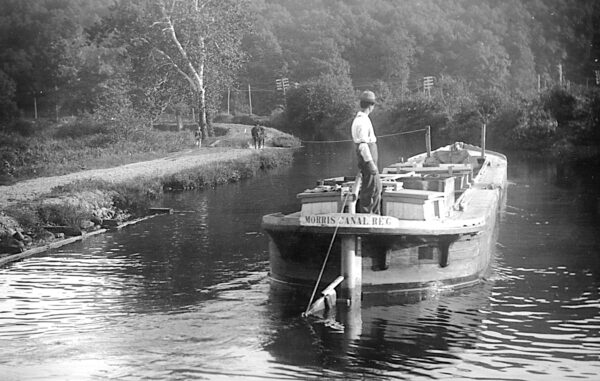At the corner of Lock and New Streets in Newark, New Jersey, busy students enter the New Jersey Institute of Technology campus. Most are unaware that this corner was once a bustling checkpoint along the Morris Canal, a now-forgotten 100-mile, man-made water highway. Gone is Lock 16E and the lock tender’s house, which gave Lock Street its name. Gone is the nearby canal basin, where boatmen could load and unload cargo and tie up their boats for the night. Gone, in fact, is any trace of a waterway having run through the city’s center. Yet this now-disappeared transportation infrastructure helped shape Newark into an industrial powerhouse.

Photo courtesy Canal Society of New Jersey
The Morris Canal was an engineering marvel, part of the canal-building boom set off by the opening of the Erie Canal in 1825. Completed in 1831, the Morris Canal scaled the hilly terrain of New Jersey’s iron-producing region, connecting Phillipsburg near the Pennsylvania border to the banks of the Hudson River in Jersey City. Shipping goods from one end of the state to the other took just five days. Canal boats, 90 feet long and laden with goods including coal, iron ore, manure, wood, whiskey, and cider, made pickups and deliveries up and down the route, creating a business-to-business transportation network that connected once-isolated farms, gristmills, and iron mines with manufacturing facilities and ports.
But it was hard-stone anthracite coal extracted from the hills of eastern Pennsylvania that changed everything. Discovered in the late 1790s, anthracite coal seemed unnecessary. Colonial American machinery was mostly powered by waterpower and charcoal (made from partially burned wood); homes were heated with firewood. But in the early 19th century, when deforestation caused a massive fuel shortage in much of New Jersey and parts of southern and eastern Pennsylvania, anthracite coal became the way forward for both home heating and industrial processes. And canals were essential for bringing coal to market.
Though the Morris Canal itself was never a financially successful enterprise, businesses along its route prospered. Small communities like Boonton, Waterloo, and Rockaway catered to canal traffic, and the iron industry grew as companies located manufacturing plants in towns along the canal to take advantage of nearby iron mines and transportation. Coal transformed Newark from a town of home businesses into an industrial powerhouse. Between 1830 and 1910, the city’s population grew from 10,953 to 347,469, and by 1911, there were some 2,000 factories in Newark. Here at the intersection of New and Lock Streets, the factories were humming, including T. P. Howell and Co., a massive leather manufacturing plant. In 1912, the company dominated the corner, with 24 buildings spread across six acres, and it claimed to be the largest producer of patent leather in the world.
The Morris Canal’s heyday was short-lived. Shipments peaked in 1866, and canal boats were replaced by the big tech of the day—the railroads. Unlike boats, which did not operate at night or in winter, trains ran 24/7, 12 months a year. They cut the time to cross the state from five days to just five hours. By the early 1900s, canal traffic was down to a trickle.
Today, Newark’s portion of the canal is long gone, transformed into the Newark subway system (now the light-rail) in the 1930s. Gone, too, are most of the city’s industrial facilities, including T. P. Howell, which closed in 1931. In fact, by the mid-1960s, as factories continued to shutter, industrial remains at the corner of New and Lock Streets were bulldozed to make way for the expansion of NJIT. Today, this intersection is the unofficial gateway to campus. All that is left of T. P. Howell’s massive compound is a single building, now known as the Lock Street apartments. It is an aging brick structure with a perpetual leak in its foundation—perhaps a sign that somewhere, buried deep beneath the ground, is an old canal basin that doesn’t want to be forgotten.
Miriam F. Ascarelli is senior university lecturer in humanities and social sciences at the New Jersey Institute of Technology.
This work is licensed under a Creative Commons Attribution-NonCommercial-NoDerivatives 4.0 International License. Attribution must provide author name, article title, Perspectives on History, date of publication, and a link to this page. This license applies only to the article, not to text or images used here by permission.
Related Articles
Sorry, we couldn't find any articles.